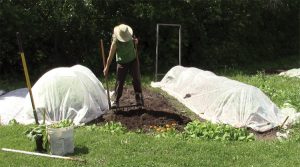Bulletin #4311, Planning and Managing a Community “Giving” Garden in Maine (Sections 6-8)
Adding Fertility Using Organic Production Methods
All fertility should be added to a garden based on soil tests. (See Bulletin #2286, Know Your Soil: Testing Your Soil for more information about testing your soil.) Lime and compost are the most important materials to add to improve the soil both chemically and physically. I am a fan of and use only organic production methods in my home garden and at the Orono Community Garden. We can grow high quality vegetables with great productivity without traditional fertilizers and pesticides. We can control insects (see Controlling Insects Organically), fungal pests, and weeds easily enough, and soil fertility can be easily managed with organic fertilizer sources, but you will need to replace the ease of conventional production with vigilance. Pest issues can develop quickly, so staying on top of plant health is key.
Proper Use of Compost
Many people want to supply their garden’s fertility with compost. You will over apply compost if you try to use it to meet the plants’ fertility needs. Too much compost can actually be problematic over the long term. Plus, compost is precious stuff. It’s better for building soil structure. In your initial production year, you should likely put out an inch or two of compost and work into the beds. See the section Double Digging to find out how to get compost deep into the bed and encourage deeper root growth. The compost will help build soil aggregation (which relates to its ability to resist erosion), improve the soil’s capacity to absorb water (infiltration), and hold water during periods without precipitation (water-holding capacity). In subsequent years, I add about 0.5–1 inch of compost to the surface of a bed, work in with a broadfork or shovel, and rake the bed surface.

A broadfork is a wonderful tool that has between five and nine heavy-duty tines and two handles. You can jump on the tool to sink the tines deep into the soil, and then you can rock back and pull the broadfork back toward you to loosen the soil. The 9-tine tool is also an excellent tool to dig up carrots and parsnips when that time comes. You can start at one end of a bed and work backwards to the other end to loosen any soil you might have compacted in the process.
Feeding Plants
If compost is used primarily for building soil structure, you will need some immediate soil fertility. In an organic garden, several sources of fertility can help plants grow well. If I have access to them, I like to apply meals (ground nutrients) when I form beds. Meals can include soybean meal, blood meal, cottonseed meal, or mustard meal. Application rates for these are provided on your soil test forms. But often I don’t have meals, I rely on fish emulsion to provide a dilute but effective nutrient source for my plants. It comes in quart, gallon, or multiple gallon containers and can be purchased at hardware stores or in bulk from manufacturers. In a 2.5-gallon watering can, I will put about 0.5–1 cup of fish emulsion into the container, and fill this with water. The liquid should have a light brown appearance, and it is strong smelling. So, it is often best to wait until the end of the garden day to fertilize your plants so you don’t scare off volunteers.
The next thing to determine is how often to fertilize. I never use fish emulsion until I see that my seedling transplants are starting to grow or seeds have germinated and have an inch or two of growth. Fish emulsion can be expensive and should be used appropriately. I will apply fish emulsion two to four times in a season to each crop, depending on the crop (Table 1).
| Plant type | Number of fish emulsion applications/season |
|---|---|
| Chenopod family (spinach, Swiss chard, beets) | 2–3 |
| Aster family (leaf and bunch lettuces) | 2–3 |
| Umbels (carrots, parsnips, and parsley) | 2–3 |
| Legumes (peas, beans), no inoculum* | 2–3 |
| Legumes (peas, beans), with inoculum | 1 |
| Alliums (leeks, onions, garlic, shallots) | 3–4 |
| Solanums (potato, tomato, eggplant, peppers) | 3–4 (depending on soil organic matter content; maybe 2x for tomatoes) |
| Brassicas (Cabbages, collards, kale, broccoli, turnips, bok choy, kohlrabi) | 3–4 |
* Legumes can make their own nitrogen if the appropriate bacteria are present. Inoculum is sold to be applied to the seed to ensure an adequate population is present. This can be purchased from most seed company.
In complying with the letter and spirit of applicable laws and pursuing its own goals of diversity, the University of Maine System does not discriminate on the grounds of race, color, religion, sex, sexual orientation, transgender status, gender, gender identity or expression, ethnicity, national origin, citizenship status, familial status, ancestry, age, disability physical or mental, genetic information, or veterans or military status in employment, education, and all other programs and activities. The University provides reasonable accommodations to qualified individuals with disabilities upon request. The following person has been designated to handle inquiries regarding non-discrimination policies: Director of Equal Opportunity and Title IX Services, 5713 Chadbourne Hall, Room 412, University of Maine, Orono, ME 04469-5713, 207.581.1226, TTY 711 (Maine Relay System).

